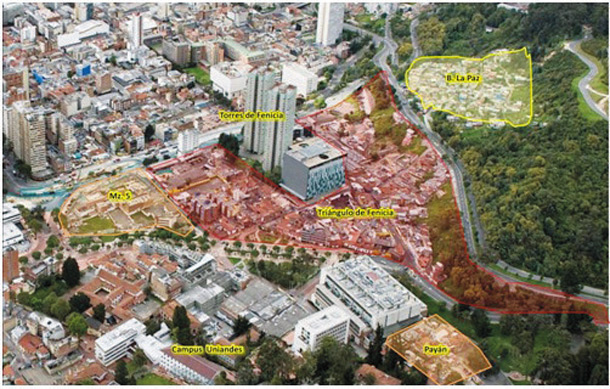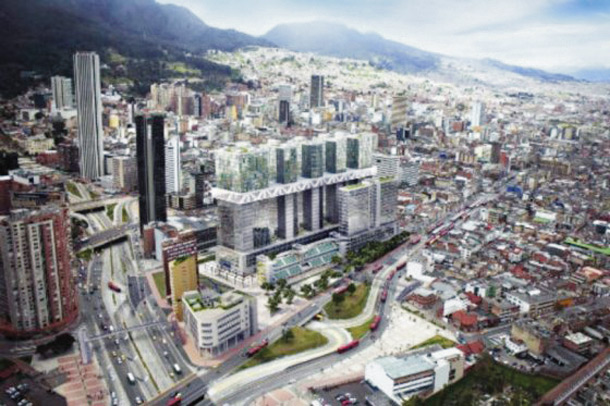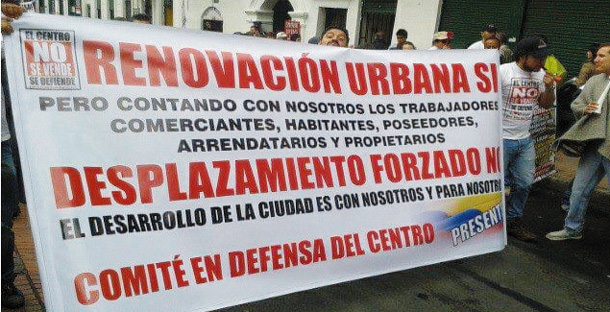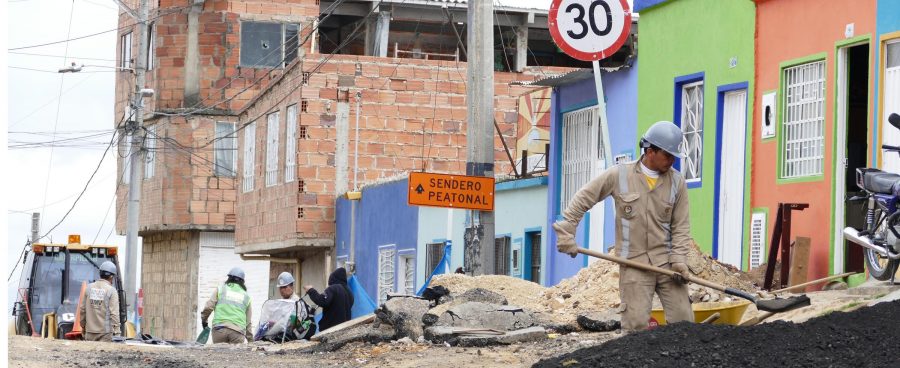
The intended Progresa Fenicia project between the triangle of Monserrate, la Quinta de Bolivar and Las Aguas.
As Plan Centro and the POT come back into the news The Bogotá Post looks into what it’s all about
The city is taking on urban revitalisation with its Plan Centro – a long-term project to integrate downtown with the rest of the city and to improve urban living conditions in the core. The initiative – approved in 2007 – falls under the territorial zoning plan (Plan de Ordenamiento Territorial or POT) and is being implemented by the Empresa de Renovación Urbana (ERU).
The initial focus was on the localities of Teusaquillo, Santa Fe, Candelaria and Martires but under the auspices of POT, the plan now reaches Avenida Boyaca and the airport in the west and as far north as Calle 80 and Usaquen.
The POT
The Plan de Ordenamiento Territorial (or POT) is the master plan for Bogota’s land-use policies. Formulated in 2000, it covers all aspects of city life – current and future – from urban to social and environmental to economic. It aims to improve people’s quality of life, to ensure that people have access to basic services and to ensure environmental sustainability. In large part, it aims to achieve these goals by focusing on the use of public transportation and encouraging the development of inner-city areas.
POT has been in the news in recent weeks as it is at the heart of the latest battle between Attorney General Alejandro Ordoñez and Bogota Mayor Gustavo Petro. The Attorney General has opened a new investigation into the mayor (who is nearing the end of his term in office), accusing him of disregarding the constitution in the way that he pushed through aspects of POT in 2013. As a result of this the Consejo de Bogota has decided to temporarily suspend Petro’s plans for renovation in the city.
More positive was the news that the pedestrianised area along Séptima between Avenida Jiménez and Plaza Bolívar has been opened, although those who frequent La Candelaria will know that a lot of work on that stretch of Séptima is still ongoing.
While El Tiempo criticised the 40% cost overrun (the project cost came to COP $14,000 million), the delays and the lack of control over street vendors, they also praised the finished zone, saying the wooden benches and plants give the space “a colourful face”.
What is Plan Centro?
Its 30-year goal is to encourage Bogotanos to live downtown through an increase in housing and commercial activity, safety improvements and the preservation of heritage areas. Another focus of the project will be the optimisation of mobility and accessibility as well as an increase in public spaces. Similar initiatives are taking place nation-wide with Medellin, Cali, Barranquilla, and Bucaramanga all planning on making long term, multi-billion peso investments to improve public spaces in their respective city centres. In Bogota, one of the important aspects of this plan is the construction of affordable housing through which some of the poorest people in the city and victims of the armed conflict could afford their own homes.
Current and future projects
One of the first projects undertaken was the renewal and pedestrianisation of Séptima between Plaza de Bolívar and Calle 26, with a total price tag estimated at COP $34,000 million, reported El Tiempo in January. Part of this has just been opened, part has not begun and work between the plaza and Calle 12b is ongoing. The maintenance of façades in the historic areas of the centre as well as the renovation of the Santa Maria bullfighting ring are some of the more cosmetic implementations of the plan. Petro recently announced that two important sectors up for renewal are along Avenida Jimenez, namely the corner with Caracas and that with Décima.
At an estimated cost of over half a billion pesos, one of the most ambitious projects on the list is the Estación Central on Calle 25, at Caracas. This megaproject, estimated to take more than 10 years to complete, is to be an underground, multi-modal transit station which would connect Transmilenio stations with above-ground infrastructure that would include housing, offices, roads and public spaces. Transmilenio and ERU have already acquired more than 90% of the terrain needed for the first phase of the project. However, it remains to be seen if private enterprises, in particular downtown property owners, will be convinced to go along with the construction of this type of public-private partnership.

This is how the new Estacion Central would look according to the plans from the ERU. Photo: eru.gov.co
With the backing of Universidad de Los Andes, Progresa Fenicia is an initiative that focuses on the urban renewal of the historic area between Monserrate, la Quinta de Bolivar and the neighbourhood of Las Aguas. This area has been changing as the university expands and becomes a student centric district, peppered with eateries and bars. Los Andes is now seeking to integrate the resident and floating population around their campus by increasing the amount of public space from 3.8 hectares to 6.2. Many of the proposed changes, which are projected to take place over the next eight years will come at the expense the local environment and current residents who are being told they will be moved into apartment buildings which will replace their current homes. Although this project is expected to cost around COP $140 million, there is no set date for construction to begin.
Criticism and shortcomings
As with many other public infrastructure projects in the city, one of the biggest questions is whether it will all get done and within what time frame and price tag. An El Tiempo report released in July said that 80% of key projects over the past 15 years have not been completed.
One example of the inability to get the work done lies in the commercial district of San Victorino. The first phase of the renovation project included the construction of commercial spaces, plazas, and warehouses – all of which have been suspended or delayed since 2007. Business owners in the area had invested up to COP $190 million in the hopes of being able to access some of the promised spaces. However, because the government failed to achieve the required balance through pre-sales of the spaces, the project stalled. Private companies have also failed to make partnership bids after two open calls for applicants. In the meantime, the city will provide some space for informal vendors, a far-cry from the promised commercial complex.
A general concern with any beautification, revitalisation, or renewal initiative is the almost unavoidable gentrification of traditionally working-class neighbourhoods. Gentrification is the process of progressively displacing original dwellers in an old or deteriorating neighbourhood by a more affluent population as the area is renewed. For example, Medellin’s urban renewal plan involves the relocation of over 6,000 street vendors and 3,000 street residents in order to ‘clean up’ its downtown zone. Where these people are to be relocated, however, remains unclear.

Demonstrators in the centre protest against the forced relocation that Plan Centro may cause.
Here in Bogota, many residents within the Progresa Fenicia project are hesitant about the changes to come. Germán Madrid, president of the community association in Las Aguas explains, “For the community it will be a drastic change in terms of its customs and housing. Because we’ll go from living in houses to living in apartments. We’ve always thought of living in an apartment as putting ourselves in a piggy bank.” Guillermo Segura, a welder in the neighbourhood comments “If you take us out of a zone to which we‘re already used to … where do you send us? We have no reason to move.”
In addition to the complaints about cost and delays, there are also questions about what will happen to Plan Centro when a new mayor is elected in October. In a March debate, all of the mayoral candidates said they would change the scheme to some degree. How the election turns out may drastically determine the future of how Bogota is planned and transformed in the years to come.
Plan Centro: In contextPlan Centro can be best understood as part of international urbanism movements that promote the densification of inner cities. This concept has been gaining ground in North American and European cities whose inner city population diminished in the 60s and 70s and moved towards the suburbs; a move facilitated by increased car use, housing shortages caused by the return of veterans from WWII, and fuelled by growing racial tensions, amongst others. Every city has unique needs that determine the feasibility of such an initiative. Vancouver, Canada, is an example of a successful core densification that was mainly achieved by building residential towers in the centre of the city. However, what makes Bogota different from North American, and to a lesser degree, European cities is that it has never had a downtown vacuum per se. While it is true that much of the middle class in older neighbourhoods such as Chapinero and Teusaquillo migrated to the north of the city, these areas are still very much inhabited, but share much more space with commercial occupants than in the past. A more accurate description of what has happened in Bogota is the mind-boggling densification of the periphery, where most of the city’s growth has taken place in the last few decades. Furthermore, Bogota’s economic downtown has shifted to include much of Séptima in the north and a long stretch of Calle 100, where many of the multinational corporations lie. As such, the city faces unique challenges and it remains to be seen if these planning initiatives will be enough to deal with the looming problems. Mayor Petro, explains: “The majority of the population lives on the fringes but works downtown and has to move great distances. The modern city is like an upside down plate (…) where the buildings are in the centre. North Americans call it downtown, and outside of it are the suburbs with low density housing, much like a mountain. Why are modern cities like this? Because they are economically rational, sustainable, can become more egalitarian, have better respect for the land, and more people live downtown.” |
By Diana Mejía and Chris Erb





